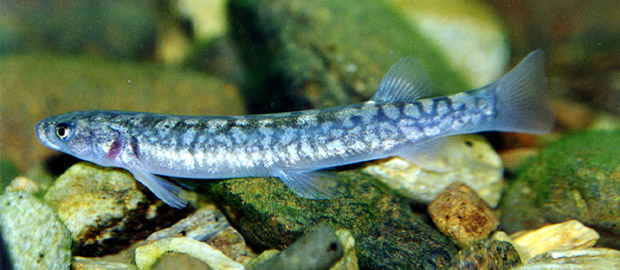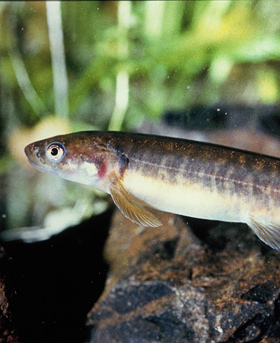|
|
| |
 |
| |
Home > New Zealand ecology > Native galaxiid fish > Koaro |
| |
| |
NEW ZEALAND ECOLOGY |
|
| |
|
|
|
|
NATIVE GALAXIID FISH |
|
| |
|
| |
| |
Koaro Galaxias brevipinnis belongs to the Galaxiidae family of the Osmeriformes order of small to mid-sized fish. It is one of only two New Zealand species of the Galaxiidae family, and one of five New Zealand native freshwater fish species that is not endemic.
It is not listed as threatened. Koaro is also found in southeastern Australia and Tasmania where it is known as the climbing galaxias.
|
| |
 |
| |
Giant kokopu appear to be the rarest of the five galaxiid species that are in whitebait runs, which enter river and stream estuaries in the spring. |
| |
 |
| |
|
Adult koaro's slim, elongate tube-like shape make it distinctly different in appearance from the other four whitebait galaxiids. It is one of the most beautiful New Zealand native freshwater fish with an irregular blotched and banded pattern that glitters in sunlight.
It is very difficult to distinguish koaro from the South Island galaxiids, roundhead galaxias G. anomalus, Eldon's galaxias G. eldoni, flathead galaxias G. depressiceps, and Canterbury galaxias G. vulgaris, flathead galaxias G. depressiceps, especially when they inhabit the same rivers and streams.
As with shortjaw kokopu G. postvectis, the lower jaw of koaro is shorter, tucked inside the upper.
Rocky, tumbling streams are the preferred habitat of koaro, and they are almost always found in streams with native bush catchments except for tributaries of upland lakes that may be above the bush-line.
A requirement for dampness could explain their preference for forested streams, and shows why their distribution in New Zealand has probably been curtailed by widespread forest clearance, more so than most of the other Galaxiidae.
Although koaro comprise part of the whitebait catch, they also form land-locked populations in river systems associated with large lakes. Banded and giant kokopu also have the ability to form land-locked populations, but have not been as successful at this as koaro. For example, koaro populations occur in the catchments of Lake Tarawera, Taupo, Manapouri, Wanaka, and many other inland lakes.
A large 270 mm fish was recently captured from Lake Pukaki.
Koaro also have the ability to penetrate well inland in many river systems, and thus have a more widespread distribution than the other whitebait species.
In addition to the mainland, they are also found on Chatham and Stewart Island, in Australia, and on the sub-Antarctic Auckland and Campbell Island.
As with all galaxiids koaro do not have scales, but have a leathery, thick skin covered with mucus. |
| |
 |
| |
|
 |
| |
 Click on image above for another koaro photo Click on image above for another koaro photo
 Double click on 2nd image to return to first Double click on 2nd image to return to first
Mature koaro Galaxias brevipinnis which has lost more definitive banding of the juvenile stage.
First image Copyright © Stephen Moore.
2nd image Stephens, Crown Copyright © Department of Conservation.
 See more on native galaxiid fish See more on native galaxiid fish
 See "The ancient Gondwana ancestry of galaxiid fish" See "The ancient Gondwana ancestry of galaxiid fish" |
| |
 |
| |
Whitebait and the migration cycle of diadromous galaxiids
As with the other four whitebait galaxiids, adult koaro make their way downstream to rivermouths in the autumn to spawn. Thousands of eggs are laid amongst vegetation on river and stream banks flooded by a spring (very high) tide. Males fertilize the eggs with large amounts of sperm (milt) that turn the water milky.
When the tide recedes the eggs sit out of water for two weeks or more remaining moist in the vegetation until the next spring tide, when they hatch and larvae are washed out to sea. The eggs of giant kokopu have never been found.
After spending four to five months of winter in the ocean, large shoals of juvenile fish (whitebait), up to 5 cm long and 3–4 mm wide, swim into river and stream estuaries on the incoming tide in spring. They make their way upstream to develop into adult freshwater fish. |
| |
 |
| |
A young adult koaro Galaxias brevipinnis showing bands which will become blotched with maturity. Photo G.A. Eldon, Crown Copyright © Department of Conservation |
 |
| |
Giant kokopu are a small part of the whitebait run. This is difficult to determine as juveniles cannot be distinguished from koaro, banded kokopu and giant kokopu. Giant kokopu whitebait migrate later in the spring and may avoid the fishing pressure.
The tiny, almost transparent New Zealand whitebait, caught in a net or screen, are primarily the migratory juveniles of inanga, koaro, and banded kokopu. Inanga make up the bulk of the whitebait catch in New Zealand, but are not present in sufficient quantities in Australia and South America.
The regulated whitebait season is from mid-August until the end of November throughout most of New Zealand except Westland. Any whitebait catch outside this period is prohibited. There are restrictions on the size of fishing gear, but there is no catch limit.
In 1902, McKenzie argued that whitebait were a distinct species from the Galaxias species, and not the young of another fish. This claim continued until 1928 when Hope kept whitebait in captivity, and watched them grow into inanga.
At different times and in some parts of the country, whitebait runs also include juvenile and adult Retropinna (smelt) and Neochanna (mudfish); juvenile Gobiomorphus (bullies), and Anguilla (eel) species. The whitebait of grayling Prototroctes oxyrhynchus were also in the runs before it became extinct.
|
| |
 |
| |
|
|
The decline of freshwater mussell and landlocked koaro in Lake Taupo .....
There is no historic record of native fish in lakes, but it is known that before and after European settlement in the mid-19th century, koaro were an important part of the diet of Maori living around the shores of Lake Taupo. Whitebait were offered to the first Europeans who visited Maori villages.
Maori fishermen used large seine nets set from canoes to bring in big catches of koaro whitebait. It is difficult to find a shoal of koaro in Lake Taupo and other lakes today.
The main cause of koaro decline in Lake Taupo is the introduction of rainbow trout Oncorhynchus mykiss and brown trout Salmo trutta.
Trout thrived on the predation of whitebait and young koaro, to boost the tourism industry with one of the world’s great trout fisheries, much to the detriment of the koaro population.
The physical condition of trout deteriorated by the early 1900s, as their abundance increased. They had consumed so much of their food source of koara that they were themselves starving.
| |
 |
| |
The linked continents of South America, Antarctica, Australia and New Zealand were an overland dispersal route 130 to 35 million years ago. |
| |
 |
| |
The first mistaken action was the netting of trout to cause a reduction, to maintain a smaller population in good condition. The next mistaken messing around with nature was the introduction of native common smelt Retropinna retropinna as alternative food for trout.
Smelt became well established, and a sustainable food source for trout which now maintain good condition. Fishing is also another factor in controlling an over-abundance of trout.
The trout, trout fishing, and tourism are doing alright, but koaro are not doing so well.
The New Zealand freshwater mussel Echyridella menziesii, which is also known as kakahi have a reproductive cycle typical of other freshwater mussels, requiring a host fish on which its larvae (glochidia) parasitize and metamorphose into juvenile mussels.
With little doubt, in Lake Taupo and also the Rotorua lakes, the fish was originally the koaro. Adult koaro were abundant and probably lived near the lake bed [McDowall, NIWA].
They would have been accessible to the mussel glochidia liberated by breeding mussels into waters close to the lake bed, and the glochidia would have attached themselves to the nearest koaro.
Today – as we have seen – koaro are largely gone from Lake Taupo, replaced by smelt and common bullies, Gobiomorphus cotidianus. Kakahi decline in Lake Taupo may be attributable to reduced numbers of koaro. |
| |
 |
|

